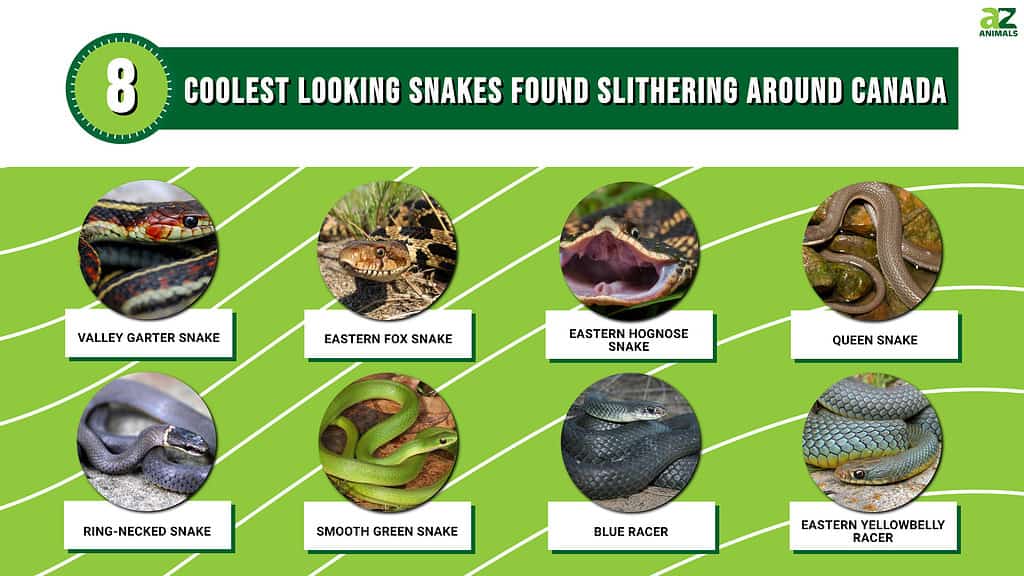
About 25 indigenous snake species live in Canada. Most of these slithering snakes though aren’t venomous or overly dangerous. Still, if you encounter a snake while in Canada, it’s best to leave it alone as snake bites still hurt!
Despite their bad reputation, snakes are helpful creatures and important parts of the environment. They are also very cool to look at and have unique markings and patterns. Here we have 8 of the coolest-looking snakes found slithering around Canada.
Do you recognize any?
1. Valley Garter Snake
The first cool Canadian snake on our list is the valley garter snake. Its scientific name is Thamnophis sirtalis fitchi. This snake is about 18 to 55 inches long, however, most only reach about 36 inches. Valley garter snakes are a subspecies of the common garter snake, which is native to North America. These snakes are brown to black with vibrant yellow stripes. One stripe is down the back, and two others are on the side. They are best known for the red bars on its side. Valley garter snakes have colorful red, black, and brown heads with yellow chins.
In Canada, valley garter snakes live in rocky areas, forests, and fields. They aren’t picky about their habitat and also live in urban areas underneath rocks and logs. They are commonly found in front yards and gardens. Valley garter snakes eat salamanders, frogs, small fish, and eggs.
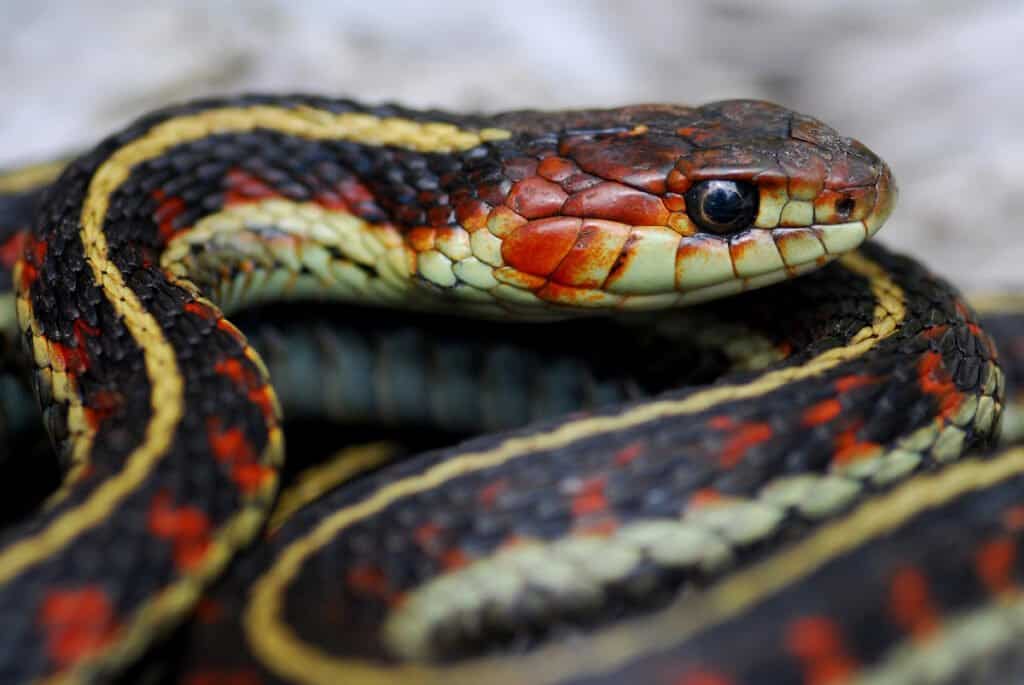
The valley garter snake’s scientific name is
Thamnophis sirtalis fitchi.
©Jason Mintzer/Shutterstock.com
2. Eastern Fox Snake
Eastern fox snakes are other cool-looking snakes found slithering around Canada. Its scientific name is Pantherophis vulpinus. They are native to the eastern Great Lakes region of the United States and Western Ontario. These rat snakes mainly live in wetlands and marshes. However, you may also find them in meadows. Eastern fox snakes eat small mammals, birds, and occasionally fish. They are also very long, ranging from 3 to 5.5 feet! They are brown, yellow, and black snakes with unique blotches. The younger an eastern fox snake is, the paler their coloration.
Eastern fox snakes are Near Threatened on the International Union for Conservation of Nature (IUCN) Red List of Threatened Species. This is mainly due to habitat loss. As wetlands are constructed on and disappear, so do eastern fox snakes.
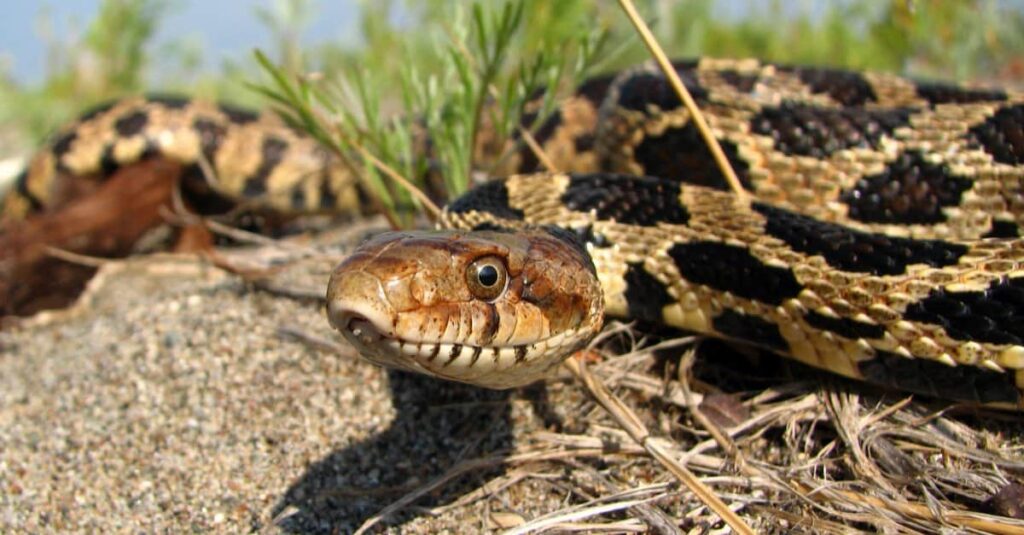
Eastern fox snakes are native to the eastern Great Lakes region of the United States and Western Ontario. They can grow up to 5.5 feet long.
©Ryan M. Bolton/Shutterstock.com
3. Eastern Hognose Snake
Eastern hognose snakes have to be one of the coolest snakes in Canada. They are easy to identify because of their ‘hognose-like’ faces. They are thick snakes endemic to North America. Eastern hognose snakes are mildly venomous. Eastern hognose snakes like as far north as southern Ontario and as south as Florida and Texas. These unique-shaped snakes are about 28 inches long.
However, they can reach 46 inches. As their name suggests, they have upturned snouts that they use to dig. Eastern hognose snakes might be easy to identify from their faces, but their coloration and patterns vary. They are sometimes red, blue, black, brown, orange, green, or gray. Some are checkered, while others have a blotched pattern.
Eastern hognose snakes are mildly venomous, meaning while a bite will hurt, the venom isn’t powerful enough to kill a human. Instead, it mainly affects amphibians. While the population of this snake species has declined, it’s still listed as Least Concern (LC) on the IUCN Red List of Threatened Species.
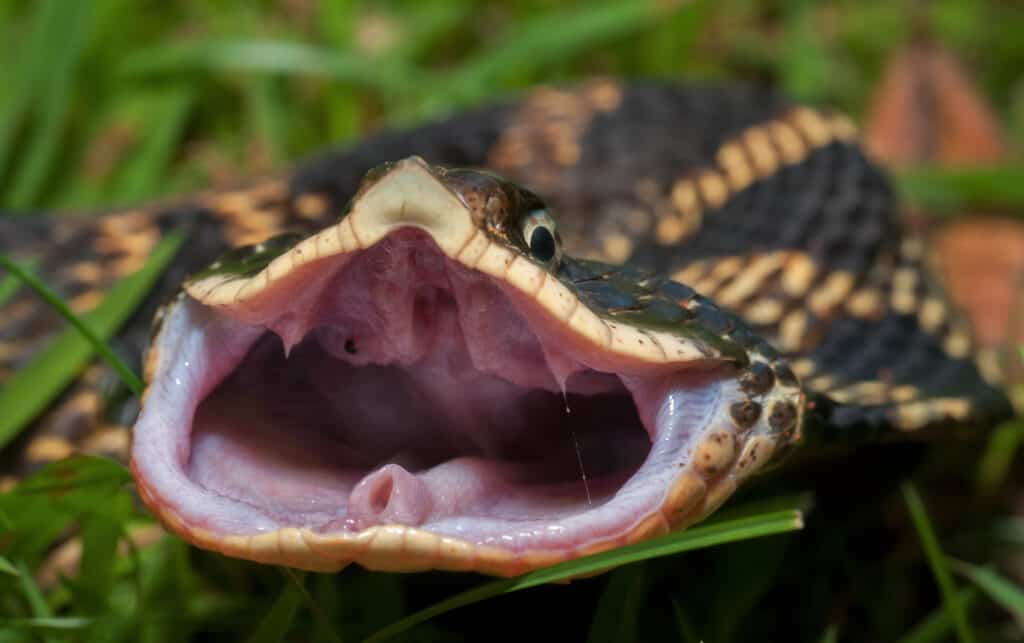
Eastern hognose snakes are mildly venomous. Their venom mainly affects amphibians like frogs.
©Mike Wilhelm/Shutterstock.com
4. Queen Snake
Have you ever heard of the queen snake? With such a royal name, you can imagine it’s one of the coolest snakes in Canada. The queen snake’s scientific name is Regina septemvittata. They are smooth and nonvenomous semiaquatic snakes endemic to North America.
Queen snakes have many names. They are sometimes called queen-banded snakes, diamond-back water snakes, moon snakes, and willow snakes. These lovely snakes are found throughout the United States including New York, Florida, and Alabama. However, they also live in the southwestern parts of Ontario.
Queen snakes are similar to garter snakes. They are about 15 to 24 inches long, with a maximum recorded length of 37 inches. Queen snakes are dark brown or olive-grey. They also have yellow or beige stripes. These regal snakes are very particular about their environment. They live near clean running water with a minimum temperature of 50 °F. The bulk of their diet consists of crayfish, but they also eat frogs and snails.
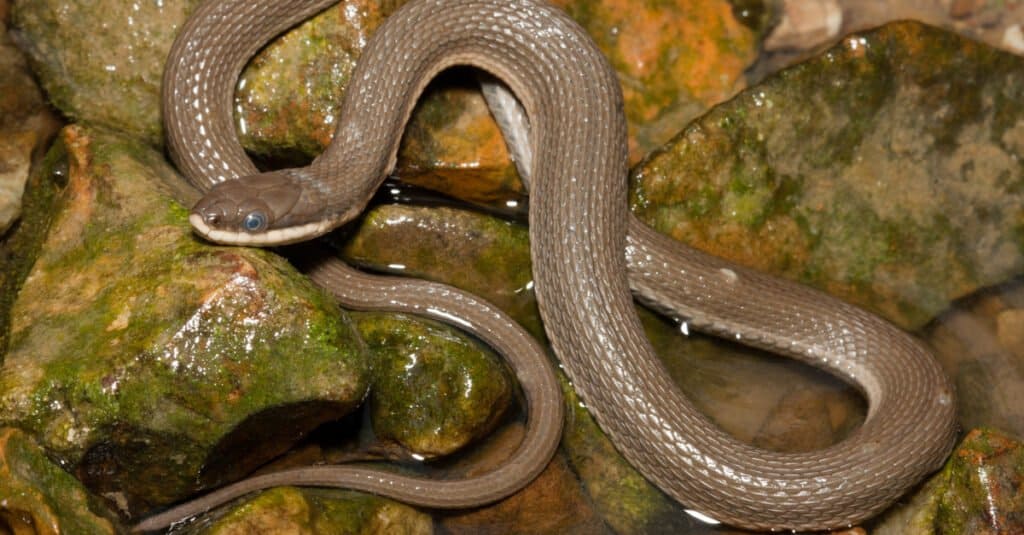
Queen snakes mainly consume crayfish, but also eat frogs and snails.
©Nathan A Shepard/Shutterstock.com
5. Ring-Necked Snake
Another unique-looking snake in Canada is the ring-necked snake, which is native to parts of North America. You can find these lovely snakes all over the United States and parts of south-eastern Canada. They’ve also been recorded in Central Mexico. Ring-necked snakes are harmless, but their vivid coloration surprises some. These nocturnal snakes are sneaky and quiet. They are rarely seen during the day and live in habitats with plenty of cover.
Most ring-necked snakes look the same, regardless of subspecies. They have black, olive, or blue-grey skin and one yellow or red band around their necks. They are also red or yellow on their undersides, broken up by black spots along the margins. Some populations don’t have a neckband. Ring-necked snakes are about 10 to 18 inches long. Their diet consists of salamanders, fish, slugs, and earthworms. To kill and consume their prey, they constrict and use venom.
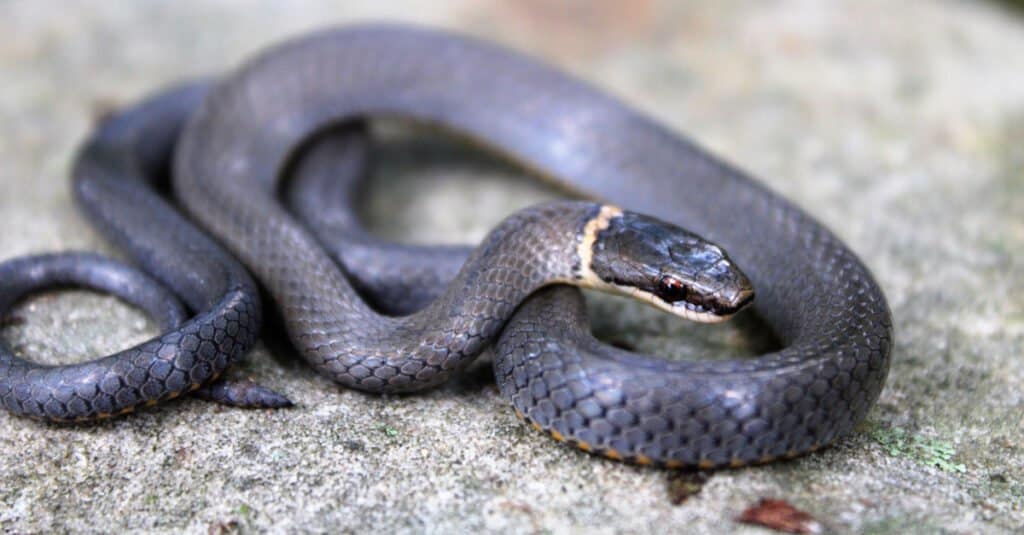
Ring-necked snakes grow up to 18 inches long
©Tucker Heptinstall/Shutterstock.com
6. Smooth Green Snake
Smooth green snakes look exactly as they sound. They are bright green snakes native to parts of North America. They are also called grass snakes. Smooth green snakes are harmless and non-aggressive snakes. They rarely bite, even when threatened. Most of the time, smooth green snakes flee when encountering humans. They are about 11 to 20 inches long, and a quarter to half of their total length is their tail! While smooth green snakes are known for their bright green coloration, they also have pale white, yellow, or beige bellies.
They aren’t always bright green. Before the first shed, smooth green snakes are olive-grey, blue-green, or brown. Smooth green snakes aren’t picky and live in many habitats including urban areas, marshes, open woods, and meadows. They rely on green grass to hide from predators and live near bodies of water like ponds, lakes, or rivers.

Adult smooth green snakes are about 11 to 20 inches long.
©iStock.com/tamers1
7. Blue Racer
One of the absolute coolest-looking snakes found slithering around Canada is the blue racer. Its scientific name is Coluber constrictor foxii. Blue racers are a subspecies of the eastern racer. They are native to parts of the United States and Canada. However, they may be locally extinct from mainland Canada as the last recorded sighting was in 1983. Blue racers have eye-catching blue lateral scales. Not only do they look unique, but blue racers are also extremely fast. They can reach speeds up to 4.3 mph.
Blue racers brumate when temperatures drop-in groups. They are also excellent hunters and hunt in trees and on the ground. They eat rodents, small birds, and other mammals. On the other hand, young blue racers eat insects.

The Blue Racer is one of the fastest snakes known.
©Psychotic Nature/Shutterstock.com
8. Eastern Yellowbelly Racer
The last cool-looking snake in Canada on our list is the eastern yellowbelly racer. Like the previous snake, they are also a subspecies of the eastern racer. The scientific name for this vibrant and beautiful snake is Coluber constrictor flaviventris. It’s endemic to Native America and listed as Threatened in Canada. In Alberta, it’s Critically Impaired.
Eastern yellowbelly racers are thin snakes that can grow up to 60 inches long. They are fast and have grey-green skin and bright yellow or creme undersides. Eastern yellowbelly racers aren’t always green and yellow. When young, they have cream-colored bodies with brown or grey markings. Racers are excellent hunters and consume fish, amphibians, and lizards.
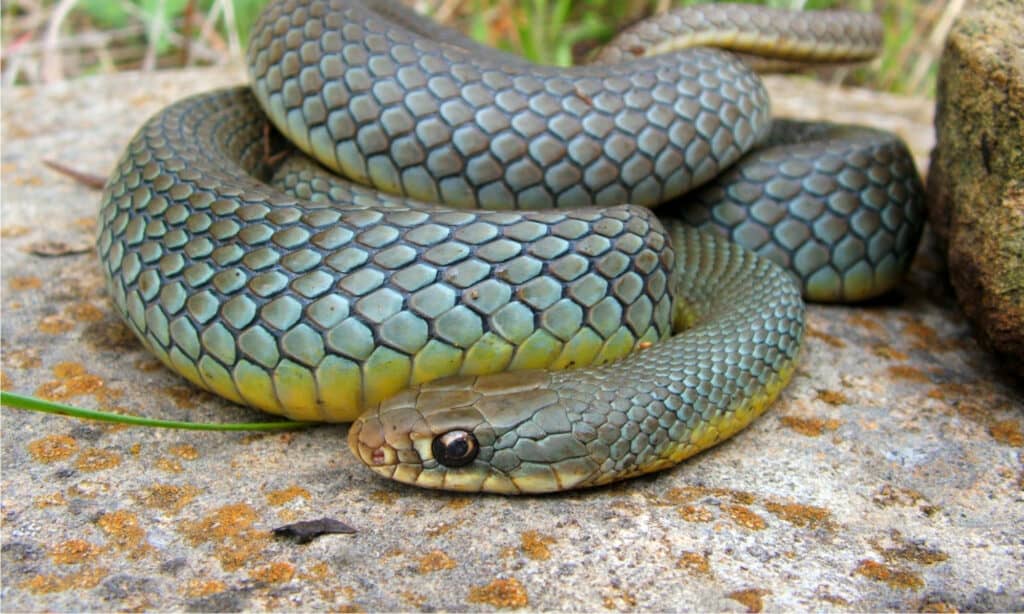
Eastern yellowbelly racers are a subspecies of the eastern racer.
©Matt Jeppson/Shutterstock.com
Summary of the 8 Coolest-Looking Snakes Found in Canada
| Rank | Cool Looking Snake |
|---|---|
| 1 | Valley Garter Snake |
| 2 | Eastern Fox Snake |
| 3 | Eastern Hognose Snake |
| 4 | Queen Snake |
| 5 | Ring-Necked Snake |
| 6 | Smooth Green Snake |
| 7 | Blue Racer |
| 8 | Eastern Yellowbelly Racer |
The photo featured at the top of this post is © iStock.com/randimal
Discover the "Monster" Snake 5X Bigger than an Anaconda
Every day A-Z Animals sends out some of the most incredible facts in the world from our free newsletter. Want to discover the 10 most beautiful snakes in the world, a "snake island" where you're never more than 3 feet from danger, or a "monster" snake 5X larger than an anaconda? Then sign up right now and you'll start receiving our daily newsletter absolutely free.
Thank you for reading! Have some feedback for us? Contact the AZ Animals editorial team.







